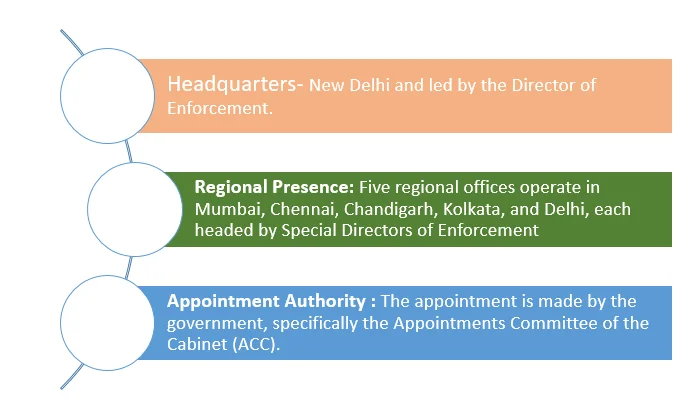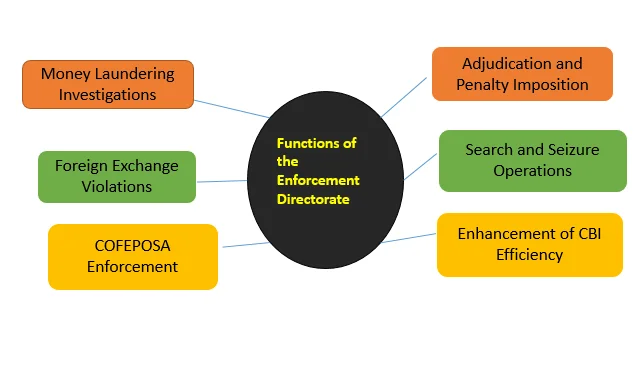The Directorate of Enforcement (ED) is India’s primary agency for investigating money laundering and foreign exchange violations. Established in 1956, it operates under the Ministry of Finance and plays a vital role in maintaining financial integrity. The ED enforces laws such as the Prevention of Money Laundering Act (PMLA) and the Foreign Exchange Management Act (FEMA). With a multi-disciplinary approach, it aims to combat financial crimes and uphold accountability in the financial sector.
Enforcement Directorate: A Comprehensive Overview
Establishment and Early Years
-
- Establishment of the Directorate: The Directorate traces its roots to May 1, 1956, when an ‘Enforcement Unit’ was created under the Department of Economic Affairs to handle violations of Exchange Control Laws under FERA, 1947.
- Initial Headquarters and Leadership: Initially headquartered in Delhi, it was led by a Legal Service Officer serving as the Director of Enforcement.
- Branches were established in Bombay and Calcutta.
- Initial Headquarters and Leadership: Initially headquartered in Delhi, it was led by a Legal Service Officer serving as the Director of Enforcement.
- Establishment of the Directorate: The Directorate traces its roots to May 1, 1956, when an ‘Enforcement Unit’ was created under the Department of Economic Affairs to handle violations of Exchange Control Laws under FERA, 1947.
- Renaming and Expansion: In 1957, the unit underwent a name change to ‘Enforcement Directorate,’ and a new branch was inaugurated in Madras (now Chennai).
- Administrative Transfer:
-
-
- In 1960, administrative control shifted from the Department of Economic Affairs to the Department of Revenue.
- Current Structure and Role: Today, it operates under the Department of Revenue within the Ministry of Finance and is the premier financial investigation agency of the Government of India.
-
- Evolution of Regulatory Laws:
-
-
- FERA, 1947, was eventually replaced by FERA, 1973, as economic liberalization gained momentum.
- Subsequently, Foreign Exchange Management Act (FEMA), in 1999, replaced FERA, marking a shift from regulatory to management-oriented legislation, effective from June 1, 2000.
-
- Introduction of PMLA:
-
- In alignment with the International Anti Money Laundering regime, the Prevention of Money Laundering Act, 2002 (PMLA) was enacted.
- The Enforcement Directorate was entrusted with its enforcement from July 1, 2005.
Organizational Structure

- Headquarters and Leadership: The Directorate of Enforcement is headquartered in New Delhi and led by the Director of Enforcement.
- Regional Presence: Five regional offices operate in Mumbai, Chennai, Chandigarh, Kolkata, and Delhi, each headed by Special Directors of Enforcement.
- Zonal and Sub-Zonal Offices: The Directorate has 10 Zonal offices, each led by a Deputy Director, and 11 sub-Zonal Offices, each headed by an Assistant Director.
- Recruitment Practices: Officers are recruited through direct methods and by drawing personnel from various investigation agencies.
- The diverse team comprises officers from IRS, IPS, and IAS backgrounds, including roles like Income Tax officer, Excise officer, Customs officer, and police.
- Tenure Extension Ordinance (2021): In November 2021, two ordinances were promulgated, allowing the extension of tenures for directors of the CBI and the Enforcement Directorate up to five years.
- Amendments to the DSPE Act and CVC Act: Amendments to the DSPE Act (for ED) and the CVC Act (for CV Commissioners) grant the government the authority to retain chiefs for one year after their initial two-year terms.
- Extensions for Central Agency Chiefs: Chiefs of central agencies, including the ED, can now be granted three annual extensions, making their tenure flexible within a total period of five years, including the initial appointment.
ED’s Jurisdiction
- Territorial Applicability: Both FEMA and PMLA have nationwide applicability, enabling the ED to take action against any individual falling under the ambit of these acts.
- Legal Venue: Cases under FEMA may be adjudicated in civil courts, while PMLA cases fall under the jurisdiction of criminal courts.
- Broad Jurisdiction: The ED exercises jurisdiction over individuals and legal entities involved in criminal activities, particularly the offences related to money laundering.
- Coverage of Public Servants: All public servants come under the jurisdiction of the ED if implicated in offences related to money laundering.
- Complaint-Based Action: The ED lacks the authority to take suo motu action; a formal complaint to another agency or the police is necessary to initiate an investigation.
- Investigative Actions: Following a complaint, the ED conducts investigations, attaching the property of the accused and making arrests as deemed necessary under FEMA and PMLA provisions.
- Adjudication Process: The resolution of the matter involves adjudication in courts or specialized PMLA courts, ensuring a legal and procedural conclusion to the investigative process.
Functions of the Enforcement Directorate (ED)

- Money Laundering Investigations: ED is mandated to investigate offences related to money laundering, tracking illicit funds, and ensuring compliance with foreign exchange laws.
- Foreign Exchange Violations: Enforces laws governing foreign exchange transactions and investigates violations to maintain the stability of India’s foreign exchange market.
- Prevention of Money Laundering Act (PMLA): Implements and enforces the provisions of PMLA, which includes tracing assets derived from proceeds of crime and ensuring prosecution of offenders.
- Fugitive Economic Offenders Act (FEOA): Executes the provisions of FEOA to attach properties of economic offenders who have fled the country to evade legal processes.
- COFEPOSA Enforcement: Empowered under the Conservation of Foreign Exchange and Prevention of Smuggling Activities Act (COFEPOSA) to sponsor cases of preventive detention related to FEMA contraventions.
- Adjudication and Penalty Imposition: Conducts investigations into suspected contraventions of foreign exchange laws, adjudicates cases, and imposes penalties on those found to have violated the law.
- Attachment and Confiscation: Has the authority to provisionally attach and ultimately confiscate properties acquired through illegal means, promoting deterrence against financial crimes.
- Supervision over Investigative Agencies: Exercises superintendence and direction over various investigative agencies, including the Central Bureau of Investigation (CBI), for cases referred to them.
- Search and Seizure Operations: Carries out search and seizure operations based on findings of money laundering, exercising powers granted under the Prevention of Money Laundering Act.
- Prosecution Sanction: Empowered to grant sanction for prosecuting public servants, transferring the authority from the government or competent authority to the Enforcement Directorate.
- Enhancement of CBI Efficiency: Implements measures to enhance the efficiency of the Central Bureau of Investigation (CBI), such as the establishment of a Directorate of Prosecution and provision of funds for cases referred by Lokpal.
- Jurisdiction Over FCRA Entities: Entities receiving significant donations from foreign sources under the Foreign Contribution Regulation Act (FCRA) fall within the jurisdiction of the Enforcement Directorate.
| Must Read | |
| Current Affairs | Editorial Analysis |
| Upsc Notes | Upsc Blogs |
| NCERT Notes | Free Main Answer Writing |
Conclusion
The Enforcement Directorate is crucial in safeguarding India’s financial system from illicit activities and corruption.
- By investigating money laundering and enforcing foreign exchange laws, the ED promotes transparency and accountability. As it continues to adapt to evolving financial crimes, the agency remains an essential pillar in India’s efforts to maintain economic integrity.
- Its ongoing work reinforces the government’s commitment to tackling financial malpractices and ensuring justice.

 GS Foundation
GS Foundation Optional Course
Optional Course Combo Courses
Combo Courses Degree Program
Degree Program











